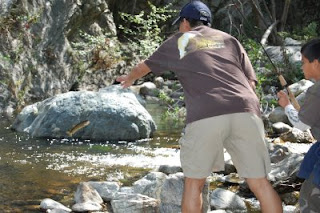A Visit to the Aquarium of the Pacific
Long Beach
 This excursion isn't just for kids. Everyone in our family likes the Aquarium, including Grandpa. It's a great place to pick up a little marine biology, and just ooh and aah over the critters.
This excursion isn't just for kids. Everyone in our family likes the Aquarium, including Grandpa. It's a great place to pick up a little marine biology, and just ooh and aah over the critters. Our recent visit started with a stop at Blue Cavern. It's that huge exhibit at the far end of the main hall. (Be sure you pick up the visitor guide when you enter the Aquarium.) When you go, take a look at some of the local fish: giant sea bass (Stereolepis gigas), California sheephead (Semicossyphus pulcher), leopard sharks, white sea bass, and kelp bass. Sheephead live in kelp forests and around rocky reefs, especially around the Channel Islands. These large wrasses all start life as females (orange to red colored) and change sex to male at around four of five years of age (when they develop the bold blue-black head and tail coloration). Large, old males are rare these days, but these fish can live 50 years.
The impressive black fish are giant sea bass. Used to be sport fishermen were especially keen to land these big guys. Now, because the animal has been fished to near extinction, it's off limits. (People often blame commercial fishing for declining marine life, but sport fishing--especially in populous Southern California--has also taken its toll.) Giant sea bass can live up to 70 years and grow bigger than 7 feet, 550 pounds.
Next, we helped our son reach into a touch pool in the Northern Pacific Gallery, upstairs. He felt a few starfish and anenomes. He also enjoyed meeting puffins--familiar from his Little Polar Bear bath book. And, of course, the southern sea otters thrilled us all. I never tire of watching these cuties. California’s sea otters were nearly hunted to extinction by fur traders in the 18th and 19th century. A few survived near Monterey, and the animals have made a slow comeback. But they haven't recovered as well as scientists think they should, and biologists continue to puzzle over the reasons. In part because of an agreement the federal government made with fishermen, today most of the state's otters live along the central coast.
Be sure to check the "Today at the Aquarium" insert in your Visitor Guide. It will tell you the times of special presentations. Most of these consist of staffers discussing the species and how they care for them.
It was great fun to watch the seals and sea lions being fed. The surfaced, jumped, slid on and off the rocks. The most common pinniped in Southern California is the California sea lion. They're easily distinguishable from harbor seals by the their brown color and longer front flippers, which allow them to be more agile on land. Plus, sea lions have external ear flaps, seals don't. I confess it's harbor seals that steal my heart. There's something about their liquid black, puppy-dog eyes, kitty-cat face, and sleek silver-black coat that makes me feel warm and fuzzy.
We also enjoyed touching rays and small sharks in the outdoor pools. While you're in the area, check out the nearby Our Watersheds exhibit. If you care about the animals you've just seen, you'll want to protect them. These exhibits will broaden your ideas on how to do that. Even if you live 50 miles from the beach, things you do inland affect the ocean. (More from me on that topic.)
Finally, while the noisy lorikeets attract a lot of attention, a quieter nook also merits a peek. Get a close-up look at some local birds in the Shorebird Sanctuary (near the seals). I adore black-necked stilts, pictured below on the left. They lend a touch of elegance to our degraded rivers. On the right is another lovely bird found in our remaining wetlands: the American avocet.
 Be sure to get a glimpse of the western snowy plover (pictured below), while you may have seen birds that look similar (killdeer, for example), chances are you haven't seen this little darling because it's endangered.
Be sure to get a glimpse of the western snowy plover (pictured below), while you may have seen birds that look similar (killdeer, for example), chances are you haven't seen this little darling because it's endangered. 100 Aquarium Way
Long Beach, CA 90802
562-590-3100
Open Daily 9 a.m.-6:00 p.m.
Adults: $23.95
Children (3-11 yrs) $11.95
Under 3: Free
Check the Los Angeles Times for coupons
Check Aquarium website for special discounts











